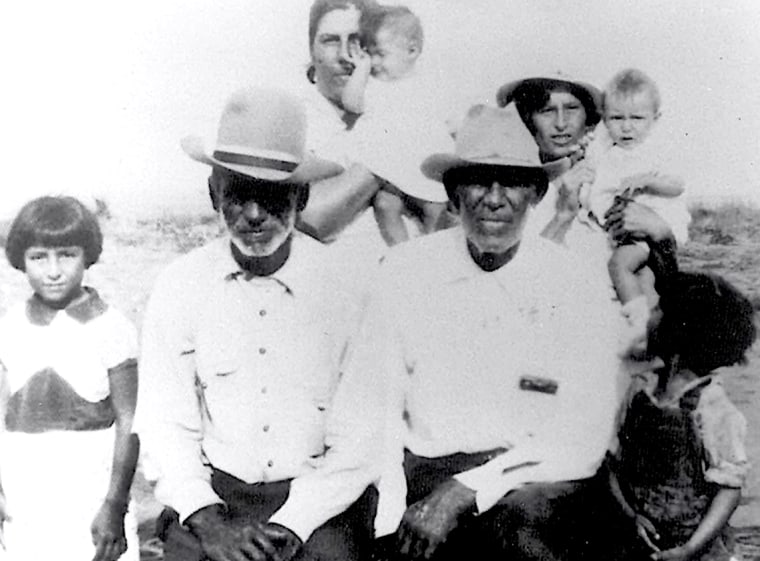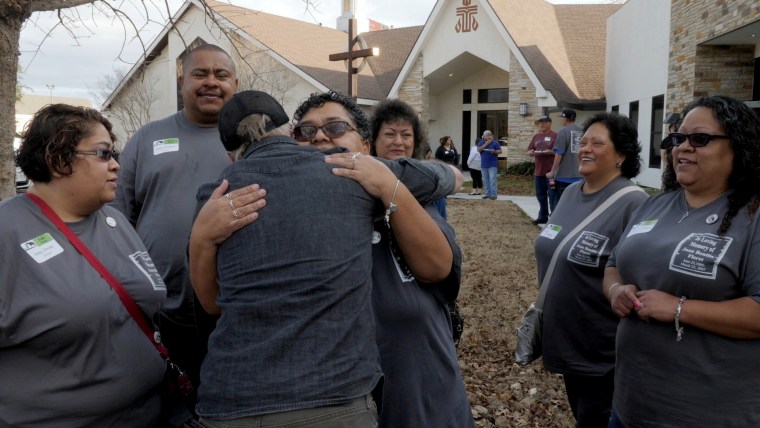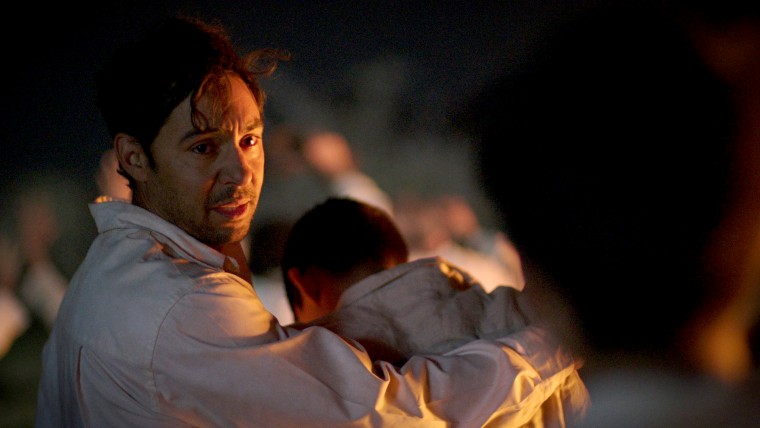“They arrive every day, all year long,” said Julie Edenborough, director of migrant services for Guymon Public Schools in Texas County, Okla., the only place to receive more unaccompanied minors per capita than Nobles County. “We’re talking about kids who couldn’t write their own name, who couldn’t hold a pencil.”
School districts like Guymon and Worthington have scrambled to hire Spanish-speaking teachers, who are part educators, part parents, part therapists. Many unaccompanied minors live with unfamiliar relatives who offer little support. Teachers often fill the void, arriving early, staying late, even buying their students groceries.
“A lot of these kids suffer horrible trauma on the journey to the United States,” said Perla Banegas, who until recently taught newcomers at Worthington High. “Some were sexually abused. Others were almost murdered by a gang or left in the desert.”
 A Worthington resident shows support for school expansion. In five years, voters have rejected an expansion five times. A sixth referendum is set for November. (Courtney Perry/For The Washington Post)
A Worthington resident shows support for school expansion. In five years, voters have rejected an expansion five times. A sixth referendum is set for November. (Courtney Perry/For The Washington Post)
Many students feel pressured to work to pay off their debts and contribute to household expenses: rent, electricity, even WiFi.
One 17-year-old asylum seeker from Guatemala said he cleaned a meatpacking plant by night, attended class by day and milked cows in the afternoon before grabbing a few hours of sleep.
But he could never fully repay the Worthington relative with whom he was living. Now 18, he’s dropped out of school, moved to another state and works construction. His asylum hearing is scheduled for March in Minneapolis but he fears he won’t have the money to attend, forfeiting his already uphill battle for asylum.
“I didn’t think the United States was going to be like this,” he said recently. “So hard.”
This school year didn’t start easily for the 16-year-old from Guatemala or the 15-year-old from Honduras. The older girl misread her schedule and arrived 45 minutes late, then had to leave to get vaccinated. The younger one arrived on time only to be scolded.
“You can’t wear shirts like that,” the attendance secretary told her in English, pointing to the Honduran’s floral blouse, which hung off her shoulders and exposed her bra straps. As a family friend who’d driven her to school translated, the girl tugged up her shirt.
The two headed toward the girl’s classroom, and the morning bell rang. “Good morning and welcome back, WHS students and staff,” a woman announced over the loudspeakers. “Please stand for the Pledge of Allegiance.”
But the girl kept walking.
“You have to stop and show your respect,” the friend whispered in Spanish. “They do this every day.”
“Ah, okay,” the girl said as she stared at the students with their hands on their hearts.
 Students learn vocabulary in a class for English learners at Worthington High. (Courtney Perry/For The Washington Post)
Students learn vocabulary in a class for English learners at Worthington High. (Courtney Perry/For The Washington Post)
'It is racism'
When Don Brink attended high school in the 1960s, Worthington was almost entirely white. But by the end of the century, the population was 20 percent Hispanic: primarily Mexicans drawn to the area’s poultry farms and meatpacking plant.
In 2007, Immigration and Customs Enforcement arrested more than 230 undocumented workers at the plant. Immigrants kept coming, however, mostly from Central America. Today the town is almost two-thirds minority. Hispanics outnumber whites.
While nearby towns have shrunk and their schools have closed, Worthington has grown. Signs in Spanish and Lao now line downtown, where Mexican restaurants compete with a new microbrewery. A Guatemalan flag flies in the window of a store selling soccer jerseys and baby blankets. On a recent afternoon, “Hello” was written on the sidewalk in chalk in 11 languages.
Even as Worthington has changed, however, its tax base still depends largely on white farmers like Brink, pitting the town’s future against its past.
In 2013, when the school district first asked voters to pay for new classrooms amid the influx of unaccompanied minors, those farmers feared they would bear the brunt of the $39 million. The bond referendum failed.
Three years later, when the school district asked for $79 million, some locals felt insulted.
“They shot for the moon,” said Dave Bosma, who transports livestock for a living. He voted for the referendum the first time around only to join Brink and others in opposing it in 2016. They called themselves Worthington Citizens for Progress, raising money door-to-door and distributing “Vote No” fliers at the town’s annual turkey race.
The group also hired a controversial
consultant named Paul Dorr, who for decades has worked to defeat public school referendums across the Midwest. Dorr’s aggressive tactics, which once included burning LGBT children’s library books in another town, only deepened the divide.
The second referendum was defeated by a 2-1 margin on Nov. 8, 2016 — the same day Donald Trump won 62 percent of the vote in Nobles County.
Attitudes have only hardened since then, as three more referendums have failed. Citizens for Progress unsuccessfully tried to oust the superintendent, and a former teacher who shared students’ private information with the group was charged with a crime. Accusations of racism have become commonplace.
“White people here don’t want to pay for people of color and undocumented children to go to school,” said community activist Aida Simon.
The rising tensions reflect broader shifts in the state. Last fall, some Republican candidates called for Minnesota to stop accepting refugees, many of whom are Somali Muslims.
“There was concern among citizens as to the cost of refugee resettlement,” said Jeff Johnson, the GOP’s gubernatorial candidate who supported a suspension. “Often the answer was ‘you’re racist.’ It shut down the discussion.”
In Worthington — where the congressional district flipped Republican in 2018 — the discussion has centered less on Somali refugees than on Central American asylum seekers, who Trump warned were “invading” the United States ahead of the midterm.
On the Sunday after Thanksgiving, Father Jim Callahan took to the pulpit at St. Mary’s Church to defend the migrants. As he delivered his sermon, boos echoed off the stained glass windows. A parishioner’s son, in town for the holiday, was heckling him.
Another man approached Callahan after a different sermon on immigration and threatened to kill him, the priest recalled. And a stranger at a gas station spit in his face.
“They can call it whatever they want,” Callahan, 69, said of the opposition to expanding the school system, “but the bottom line is that it is racism.”
Members of Citizens for Progress says their concerns are purely financial at a time when farmers are already hurting from flood-damaged crops and the trade war with China.
“On a weekly basis I’m told I hate children,” said Bosma, 37, whose kids go to a private Christian school. “I’m just a young guy trying to make a living for myself and put food on the table for my family. I look at the bank account at end of the month and say, can I afford another $200 in property taxes this year?”
Brink also insists he isn’t prejudiced. His own grandparents were immigrants from Holland, and his parents spoke some Dutch. But he doesn’t believe Worthington should be a destination for the undocumented.
“I wish they would have another ICE raid,” he said. “They need to get rid of the illegals.”
'Half the town is illegal'
The 15-year-old sat near the classroom window, her belly nearly touching the desk in front of her.
She hadn’t known she was pregnant when she left Honduras in February, after the father who’d left her behind as a baby called to tell her to join him and his new family in America. Then she’d started throwing up in her hotel room in southern Mexico.
She’d thought about turning back, back to the boyfriend who had begged her to stay.
Instead, she continued north, crossing the Rio Grande in a raft before spending two days in a Texas Border Patrol facility and a month in a Florida shelter.
Now she was 3,000 miles from home, back in school and about to give birth.
“I want to learn a little bit more about you guys,” her teacher said, first in English, then Spanish.
When it was her turn, the girl gave her name and said she’d arrived four months ago. She didn’t mention that her child was a boy or that she wanted to name him after the dad he might never meet.
She had worried she’d be surrounded by kids who didn’t speak her language. Instead, she found herself in a class with 14 Guatemalans and two Salvadorans.
Sitting across the room, the 16-year-old from Guatemala was one of the last to speak.
She was the shy youngest child of maize farmers in the western highlands who were too poor to send her to school. It had been three years since she sat in a classroom. Asked about the best part of her first day, she would later say simply: “Learning.”
She lived in what had once been a nice house near the school where the intricate crown molding was now crumbling and the wallpaper was coming off in sheets. But instead of sharing her bed with siblings, she now had her own room. The older sister who’d brought her here had decorated it with paper orchids to remind her of home.
The teacher asked the class to create name tags emblazoned with words representing them.
The pregnant girl wrote “Math,” her favorite subject.
At 1:15 p.m., she left early for a medical appointment. The doctor told her the baby was healthy but the girl cried anyway, thinking of her boyfriend.
At 2:50 p.m., the 16-year-old walked out of school with a new friend. The two girls had grown up a few miles from one another in Guatemala but only met in America, where they now live a block apart.
As they strolled home, they passed Guatemalan ladies in lawn chairs waiting for their children and an elderly white couple sitting on their porch. They oppose the referendum to expand the schools.
“We can’t afford the taxes,” the woman said later, even though she works part-time at the middle school and knows the classrooms are overcrowded.
“Half the town is illegal,” added her 80-year-old husband, an oxygen tube in his nose.
Across town, Don Brink was picking up kids at the middle school, which is 20 percent white.
He earns $83 a day from the bus route. But as he drove through the town that immigrants had revived, listening to oldies, he thought only of what has been lost. And he worried that this time, the referendum would pass.
John D. Harden contributed to this report.













